We may earn revenue from the products available on this page and participate in affiliate programs. Learn more ›
The .410 shotgun is an American standby. Countless hunters and shooters got their first whiff of gunpowder as kids by pulling the trigger of a .410. It’s a classic and handy gun to keep close by for pest control, target shooting, and small game hunting. Still, finding the best .410 shotgun for you can be tricky because it’s a specialized gun that doesn’t fit into the same niches as the other gauges. The .410 has nearly non-existent recoil and not much muzzle blast compared to larger bores, so it’s often a gun used by beginners. It has its limits in the field for wingshooting, but some prefer it for close-range birds like woodcock or decoying doves. Oddly enough, it’s become a popular choice for our biggest gamebird, too. Dense Tungsten Super Shot (TSS) turns a .410 into a potent gun for wild turkeys.
The .410 is an outlier among shotguns. It’s our smallest bore by far, measuring .410 inches versus .550 inches of the next-smallest gauge, the 28. It’s also the only shotgun designated by its bore diameter instead of gauge. “Gauge” is determined by how many lead balls of bore diameter equal one pound. If a .410 was designated like other shotguns, it would be a 67-gauge. That small bore diameter means it often patterns poorly and holds very little shot.
For many years, the 2 ½-inch cartridge holding half an ounce of shot was the standard .410 payload, and in the U.S., it became one of the four gauges used in skeet competitions. When Winchester introduced the Model 42 pump gun in 1933, the gun had a 3-inch chamber, and Winchester offered 3-inch magnum loads for it that increased payloads to 11/16 of an ounce and billed it as a hunting gun, not just a gun for skeet shooting. Within its very close-range limitations, the .410 can be effective on birds and small game. And while it is by no means as lethal at longer ranges with its limited capacity for buckshot, a 3-inch .410 hull can still hold five pellets of 000 buckshot, which is formidable at close range. Loaded with pricey TSS it will kill turkeys to 35-40 yards with ease.
In general, though, the happiest .410 shooters recognize that it’s a gun for close-range applications. Used within its limitations, though, the .410 is a gun that puts a smile on any face. Figure out which is the best .410 shotgun for you, and you, too, can wear one of those smiles.
How We Picked the Best .410 Shotguns
The popularity of the .410 means there are lots of guns on the market to choose from. There are .410s for all-around use and plenty of dedicated .410 hunting guns. I tried to put some of each on this list and judge them by the following criteria:
- Reliability: Does the gun go bang three (or two for two barreled guns) or more times?
- Quality of Construction: Is the gun well-built? How is the fit, finish, and, if applicable, decoration?
- Weight and Balance: Even the lightest .410 generates very little recoil, so the only reason for one to be heavy for its size is to make it easier to shoot, If it’s too light. If it’s too heavy, it kind of defeats the purpose of shooting a .410 in the first place. How a gun’s weight is distributed matters, too.
- Ergonomics: A shotgun has to fit, and it has to feel good in hand. Its controls should be easy to use as well.
- Price/Value: Some of the guns here are cheap, and some are pricey, but all were scrutinized to ensure a good return on your dollars, no matter how many or how few you spend.
Best .410 Shotguns: Reviews & Recommendations
Best for Turkey Hunting: Mossberg 500 Holosun Micro Dot Combo
Specs
- Chamber: 3-inch
- Action: Pump
- Weight: 6 1/4 pounds
- Length: 39.75 inches
- Barrel: 20 inches, fiber-optic bead, turkey choke
- Stock: Mossy Oak Green Leaf
- Price: $844
Pros
- All-in-one package ready to hunt
- Sight sits low in a special receiver cut to allow good cheek weld
- Proven, slick design
- Reliable
Cons
- Plastic safety can be stiff
- Mag cap feels cheap
Over 12 million Mossberg 500 pumps have been made, a testament to a design that can undercut the price of other guns yet still function reliably. Many of those 500s have been .410s. Now that the .410 is the trendy new turkey gun, Mossberg delivers the best-in-class entry with a 500 receiver cut for a Holosun 407k micro red dot in olive, which comes already installed. All you have to do is sight it in and take it hunting.
Despite its all-around greatness, the Model 500 suffers from a plastic top safety that can be sticky to press off when you have the gun shouldered. It’s easy enough to spend $25 and replace it with a tactical safety. Likewise, while the integral barrel nut can’t be lost, it can be a pain compared to a regular magazine cap. That’s about the end of the Model 500’s shortcomings. If you want to hunt turkeys with a .410, it doesn’t get much better than this combo. It also comes in a Bantam version with removable stock spacers to fit smaller shooters.
Best Semiauto: Tristar Viper G2
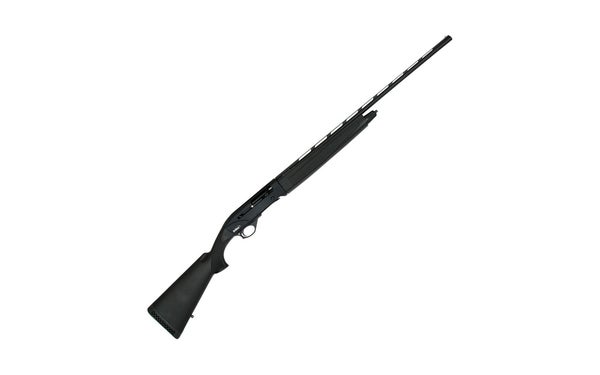
Specs
- Chamber: 3-inch
- Action: Gas semiauto
- Weight: 5.7 pounds
- Length: 48 inches
- Barrels:26 inches (wood only) or 28 inches (synthetic only)
- Stock: Black synthetic (camo available and two walnut grades available)
- Price: Starts at $745 (synthetic)
Pros
- Affordable
- Reliable gas operation shoots all loads without adjustment
- Lightweight and built on a small-bore frame
Cons
- Safety does not reverse for left-hand use
There aren’t many .410 semiautos around, but that doesn’t mean the Tristar wins this award merely by default. It is lightweight, fun to carry, recoilless to shoot, and most importantly, it works. Tristar actually builds its small-bore guns on small-bore frames, whereas some other .410s are built on 20-gauge actions, making them unnecessarily bulky. The gas system is simple, with few parts and a return spring around the magazine tube, which can be easily reached for cleaning. The Viper is made in several different styles for different uses, from a utilitarian black synthetic model to a pistol-gripped turkey model and other finishes that include walnut.
Best O/U: Beretta Silver Pigeon I
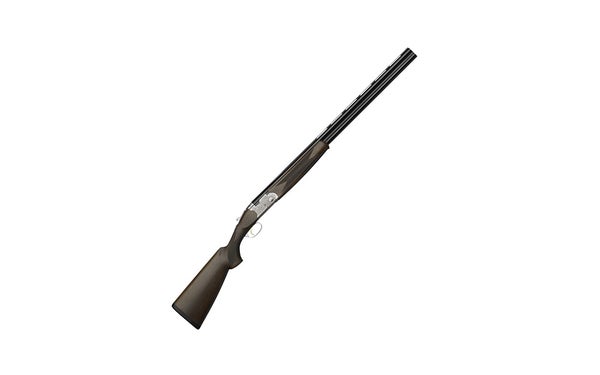
Specs
- Chamber: 3-inch
- Action: Break-action O/U
- Barrel: 26- or 28-inch vent rib, brass bead, choke tubes
- Length: 45.5 inches with 28-inch barrels
- Weight: 6.5 pounds
- Stock: Walnut
- Price: $2549
Pros
- Proven, durable action
- Built on a small-bore frame
Cons
- Safeties sometimes sticky
Known around the world as a gun that’s as tough as it is graceful and good-looking, the Silver Pigeon is made in .410 on a small-bore frame it shares with the 28-gauge version. That makes it trimmer than the 20-gauge, if not lighter, due to the thicker barrel walls needed to fit the larger 28-gauge frame. Still, it’s a slim delight in hand, and that extra weight helps it swing smoothly. And don’t underestimate it because it’s petite: this gun will last thousands upon thousands of rounds with proper care. The Silver Pigeon features blued barrels and a coin-finished receiver engraved with traditional scroll patterns. The walnut is matte-finished with a traditional checkering pattern, a full pistol grip, and a Schnabel forend.
Best .410 Target Gun: Browning Citori 725 Sporter
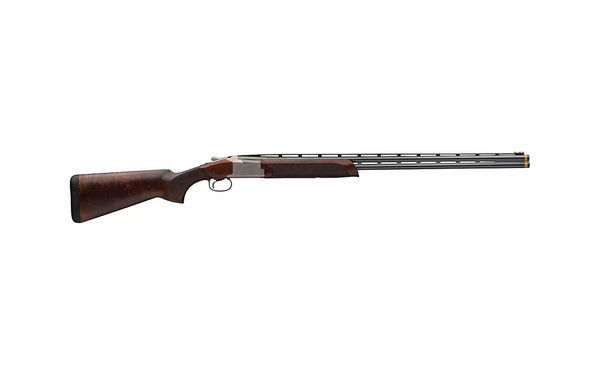
Specs
- Chamber: 3-inch
- Action: Break-action O/U
- Barrel: 30 or 32 inches, vent rib, vent mid-rib, fiber-optic bead, extended choke tubes
- Length: 50 inches
- Weight: 7 pounds, 7 ounces
- Stock: Gloss oil-finished walnut
- Price: $3599
Pros
- Weight and length for a smooth swing
- Excellent reliability
- Good trigger pulls
Cons
- Right-hand palm swell useless for lefties
- Pricey
Don’t knock the idea of a 7 ½-pound .410 with long 30- or 32-inch barrels until you try it. The extra weight and length of the 725 points steadily and swings smoothly, giving you the best possible advantage when you’re trying to put a half-ounce of shot onto a speeding clay. And the 725 Sporter’s 3-inch chambers mean you can take it to the dove field, too, if you need an extra challenge.
A refinement of the original Citori, which itself was a version of John Browning’s famous Superposed, the 725 action is trimmed down to make the gun lighter, sleeker, and more responsive than the older models. It features a good mechanical “Firelite” trigger boasting clean pulls, a barrel selector incorporated into the safety, ejectors, a fiber-optic bead, and five extended choke tubes. Recoil pads don’t matter a lot with soft-kicking .410s but Browning adds a good one anyway with its Inflex pad. Browning barrels are also famous for shooting straight and putting lots of pellets on target, which is very important in a .410 when you don’t have any pellets to spare.
Best Budget: Stevens 301
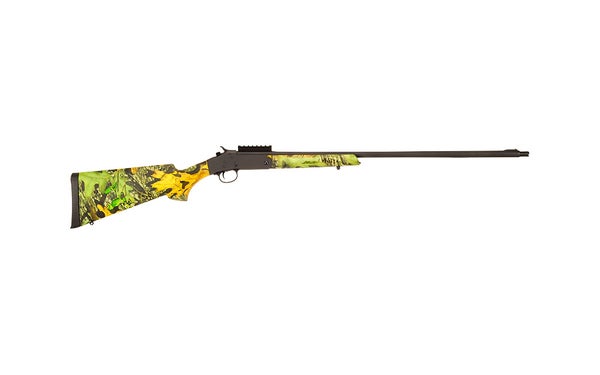
Specs
- Chamber: 3-inch
- Action: Break-action single shot
- Barrel: 22 inches, no rib, comes with one Modified choke tube, bead sight
- Length: 36 inches
- Weight: 4.6 pounds
- Stock: Black or camo synthetic
- Price: $239
Pros
- Affordable
- Simple, reliable action
- Shorter stock and very light weight make it good for kid’s first shots
Cons
- Safety is redundant
- Strong ejector spring trips whenever you open the gun
- Matte steel finish rusts easily, must be kept clean
The Stevens 301 is essentially a Chinese-made copy of the now-discontinued H&R single shots that were a staple youth and pest-control gun for so many years in the United States. This new bare-bones Stevens version has a synthetic stock and matte steel finish. With a stock measuring 12 ¾-inches and a weight under 5 pounds, it’s a gun anyone can handle, even the youngest shooters. That said, the hammers can be tough for young people to cock, and to make them easier (and safer), you can invest a few dollars and a few minutes to install an aftermarket hammer extension.
Unlike the original American single shots, this gun has a manual safety that’s not entirely necessary. The hammer has a transfer bar mechanism that prevents the gun from going off if it’s bumped when the hammer is down or if your thumb slips as you’re cocking it. That flaw aside, it’s hard to beat this gun for the money, even if you pay the full list price for it.
Most Fun: Henry Lever-Action
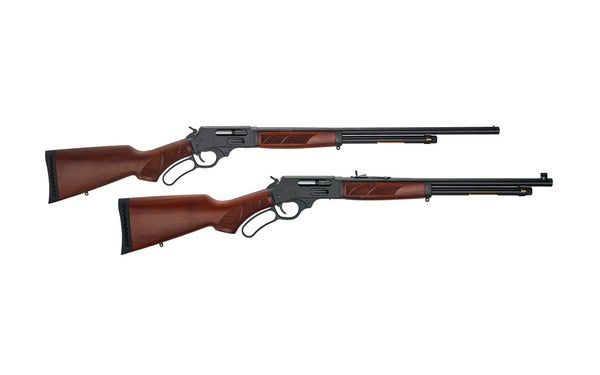
Specs
- Chamber: 2 ½ inches
- Action: Lever action with a six-round tubular magazine
- Barrel: 24-inch round barrel, brass bead, and choke tubes (Cylinder bore, the adjustable iron-sighted 20-inch barrel also available)
- Overall length: 42.75
- Weight: 7.5 pounds
- Stock: Walnut
- Price: $1138
Pros
- 6+1 capacity
- The receiver is drilled and tapped for scope mounting
- Swivel studs and recoil pad standard
Cons
- Heavy
- Expensive
- Not chambered for 3-inch shells
Most people use their .410s for plinking and fun, and this lever gun from Henry gives you seven shots as fast as you can work the lever. While it is a fun gun, it’s definitely an adult plaything, as its 7 ½-pound weight makes it too heavy for most kids to use. The gun can be loaded both from its tubular magazine and through a side loading gate on the right side of the receiver. A transfer bar prevents discharge if the gun is dropped or bumped and does away with the need for a trigger-block safety button.
Although limited to 2 ½-inch shells, the Henry still allows you to shoot light, ½-ounce field loads, four-pellet loads of 00 buck for home defense, and 1/5-ounce slugs for bigger coyotes and for defense.
Best .410 Shotguns: Things to Consider Before Buying
Buying a .410 is no different than buying any other shotgun, except for this: it will not be an all-around gun, nor will it be your only shotgun. Therefore, the way to buy the best .410 shotgun is to think carefully about what you need it for and to buy a gun that plays to the .410’s strengths of low recoil and softer muzzle blast.
For instance, a dedicated .410 turkey gun like the Mossberg Model 500 Holosun Micro Dot combo has become a solid trend in the turkey woods because it maximizes the tight patterns and low recoil of .410 TSS loads. Likewise, the 725 Citori is the best choice for target shooting because it is specialized to make it easier to hit clays with a small .410 payload. The gun can be long and heavy because it’s not one you’ll carry around.
At the other end of the spectrum, the Stevens single-shot is light and compact, making it a great, inexpensive choice for someone who wants a gun for occasional plinking fun and some pest control. It’s also a good gun for younger/smaller shooters who may be leery of recoil. One thing you should consider about any .410 purchase is that ammunition is expensive. If you plan to shoot your .410 a great deal, you might consider reloading your own ammunition to save money.
FAQs
Q: Does the tight bore of a .410 hold tighter patterns than bigger bores?
On the surface, it would seem to make sense that if you run a bunch of pellets through a small tube, they will stay together in a tight clump. But shotgun ballistics don’t always make sense. The myth that the .410 holds tight patterns has been around forever. In fact, the tighter bore of the .410 often shoots bigger patterns than larger bores, especially with soft shot like lead and bismuth. The tall, thin shot columns packed into a skinny .410 hull mean many pellets become deformed as they travel down the muzzle. Larger shotgun bores deform fewer pellets and are more efficient.
Q: Is the .410 a good gun for beginners?
Yes and no. The .410 has some important advantages as a gun to learn on such as low recoil, lightweight build, and minimal noise. All those advantages make it a good gun for those who might be intimidated or put off by the weight, recoil, and muzzle blast of a bigger gun. That’s the yes argument.
On the other hand, .410 ammunition is much more expensive than 20-gauge ammo. And, as much fun as .410s are to shoot, they are hard guns to hit flying targets with because they pattern poorly and don’t hold much shot. Nor does their light weight help them point and swing well. Many people would argue that heavier 20- or 28-gauge makes a better beginner gun. Despite this, millions have taken their first shot with a .410, and millions more will.
Q: Is the .410 good for home defense?
The .410 shotgun is by no means a combat shotgun, but it has its advantages and disadvantages as a home defense weapon. Its light weight and low recoil mean it’s not a difficult gun for any appropriate family member to learn how to shoot and handle. And, at very close range, the four or five-pellet 00 buck loads are more than enough to stop an attacker if you put them on target. There are also .410 loads of 4 bird shot made for home defense that will create horrible wounds at close range without passing through too many walls and endangering the neighbors.
Best .410 Shotguns: Final Thoughts
Almost every shotgunner owns a .410 for one reason or another. They are fun guns to shoot, and that alone makes finding the best .410 shotgun for your purposes a worthwhile project. Bear in mind, though, that it is very limited in use. As a hunting gun, it’s fine for very close-range doves or upland birds that flush in your face in a thicket. Even 3-inch hulls don’t hold much non-toxic shot (except for very expensive TSS) to make the .410 a good waterfowl hunting gun. And almost all .410 ammo costs more than equivalent bigger-bore shells.
Understand going in that the best .410 shotgun will not be a general-purpose gun the way a versatile 12- or 20-gauge can be. It will be a fun specialty gun, so you need to consider what you will use it for, then choose the best .410 shotgun for your needs.
Why Trust Us
For more than 125 years, Field & Stream has been providing readers with honest and authentic coverage of outdoor gear. Our writers and editors eat, sleep, and breathe the outdoors, and that passion comes through in our product reviews. You can count on F&S to keep you up to date on the best new gear. And when we write about a product—whether it’s a bass lure or a backpack—we cover the good and the bad, so you know exactly what to expect before you decide to make a purchase.
Read the full article here




